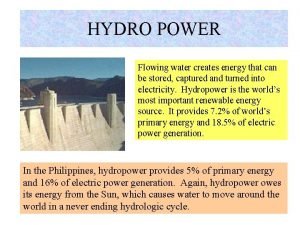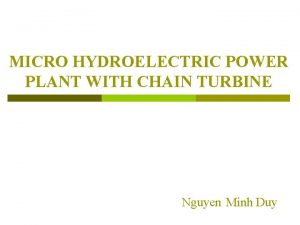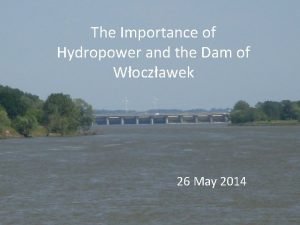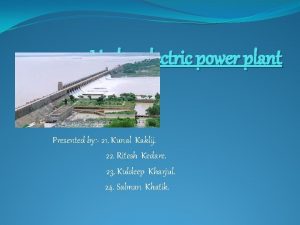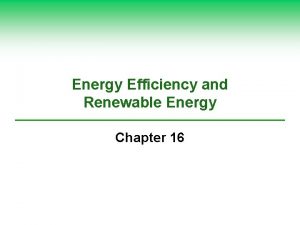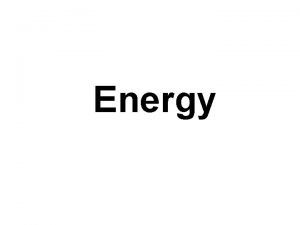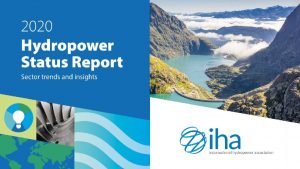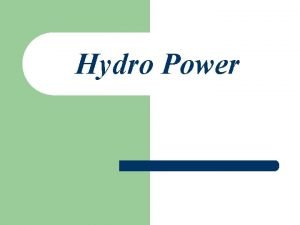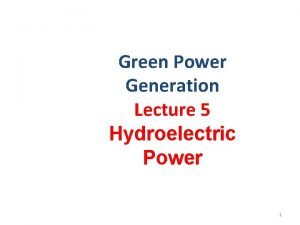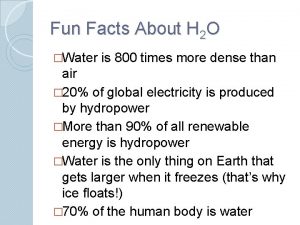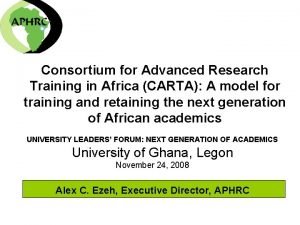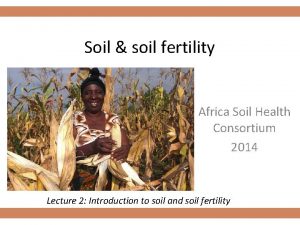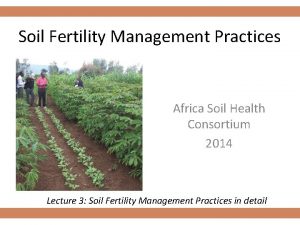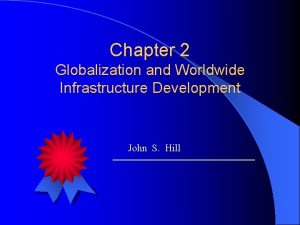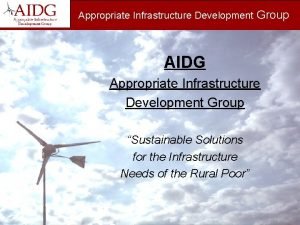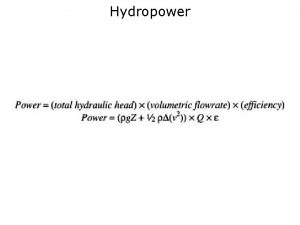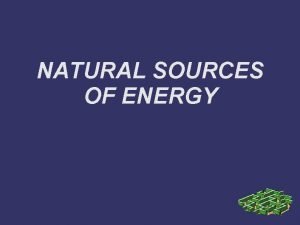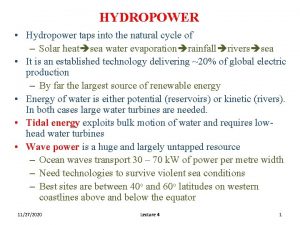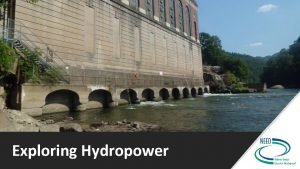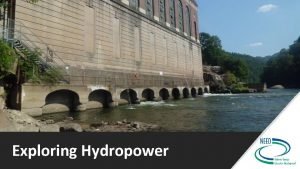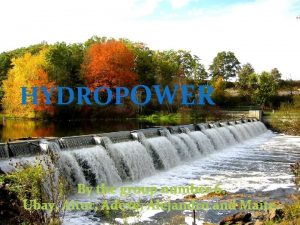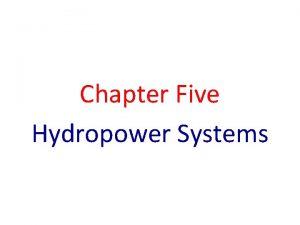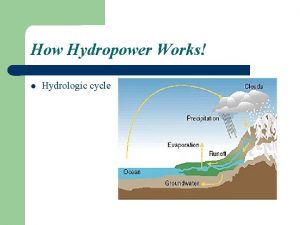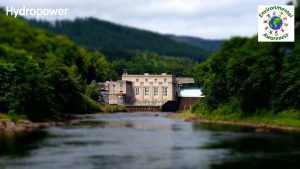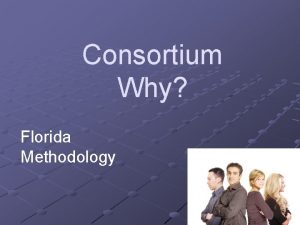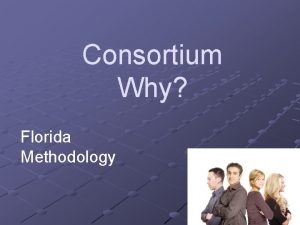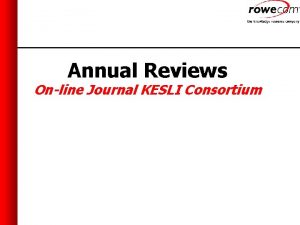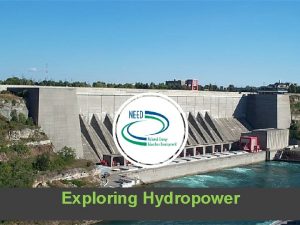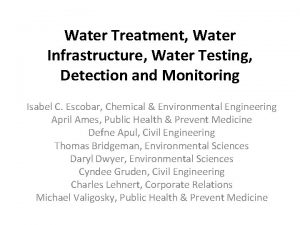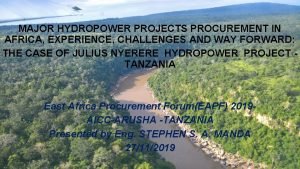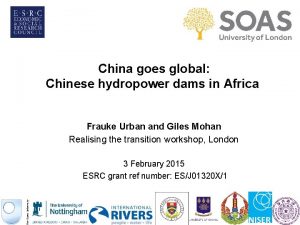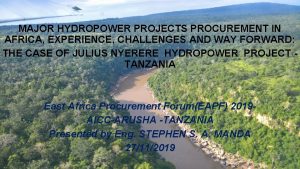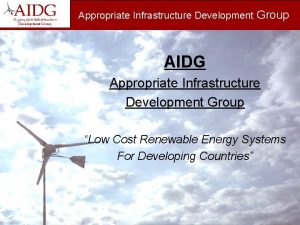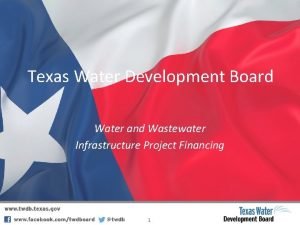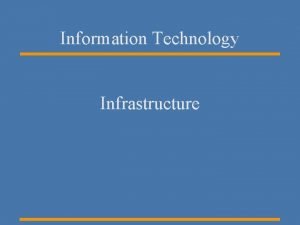The Africa Infrastructure Consortium Africa Water Development Hydropower








































- Slides: 40

The Africa Infrastructure Consortium Africa: Water Development, Hydropower & Growth

3 Messages: Africa, growth, water development & hydropower 1. Africa’s ‘dual’ water resources legacy is a major constraint to growth 2. The infrastructure gap is huge & must be addressed in innovative ways 3. Hydropower: anchor infrastructure for multipurpose water development

A natural legacy : massive climate variability Risk of recurrent drought much higher rainfall variability than USA Kenya: variability & shock

Kenya winter flood 97/98 $2. 39 b infrastructure damage Kenya 1998 -2000 drought $2. 41 b losses

Kenya: climate, shock & competitiveness - Drought & flood in Kenya: Impact 22% GDP/ annum - transport 50% - energy 13% - industrial production 29% Investment Climate Assessment in Kenya: • low competitiveness, indirect costs 20 -30% of total costs vs. 7 -12 % for strong performers • transport 31% & energy 19% of indirect costs. Source: Business Environment & Comparative Advantage in Africa: Evidence from ICA data; Jan. 2005

with drought in Kenya in 2000…. . . massive flooding in Mozambique -23% +44%

Ethiopia: variability and growth Rainfall & GDP growth: 1982 -2000 Infrastructure platform Impact of historical levels of variability on 2003 -2015 growth projections 38% decline in avg. projected GDP growth rate when historical levels of variability are assumed Ethiopia Country Water Resources Assistance Strategy: preliminary results of the baseline scenario (2005)

Africa’s colonial legacy: many international rivers 60+ basins More int’l rivers shared by 3 or more countries than any other continent Every country has at least 1 37 countries have 2 or more 15 countries have 5 or more è future dev’t increasingly on int’l rivers è political complexity è requires capacity and resources è few clear int’l guidelines è no overarching authority

3 Messages: Africa, growth, water development & hydropower 1. Africa’s ‘dual’ water resources legacy is a major constraint to growth 2. The infrastructure gap is huge & must be addressed in innovative ways 3. Hydropower: anchor infrastructure for multipurpose water development

7, 000 6, 150 6, 000 4, 729 5, 000 4, 000 3, 255 2, 486 North America Australia Brazil China 0 746 1, 406 43 South Africa 1, 000 1, 287 Laos 2, 000 Thailand 3, 000 Ethiopia River regulation, storage & poverty Water storage in m 3/cap • River regulation/storage needed to reduce impacts of drought/flood & often essential for poverty eradication • dams & reservoirs have been extensively implemented in developed countries, regulating almost all rivers • but, poorly implemented, they can cause significant adverse impacts on local communities & the environment

Water storage/security investment gap: proxy of 750 m 3/cap/yr (SA, 10% of USA) Country Additional Storage needed person (m 3) Storage investments required person (US$) Storage Investments Required (US$ Billion) Period needed at 5% current GDP investment per year (no pop. inc. ) (Years) Lesotho 751 939 1. 7 44 Namibia 542 678 1. 3 8 Nigeria 402 503 67. 3 32 Ethiopia 555 694 46. 2 144 Kenya 307 384 12. 1 24 Tanzania 610 763 27. 4 60 Uganda 511 639 17. 9 58 Burkina Faso 152 190 2. 5 22 Senegal 683 854 9. 9 40

World’s realistic potential developed: 33 % Current hydro production: 2740 TWh/y Realistic potential production: >8000 TWh/y 75% 69% 22% 33% 7% 49% Current hydro generation: Africa = 80 Asia = 800 Australasia = 43 Europe = 570 N/C America = 700 S America = 550 (TWh/year) Source: World Atlas of Hydropower & Dams, 2002

Hydropower potential tapped …electricity gap

E. Africa-Europe: Hydropower comparison Popul. GNP/cap HP pot. Mill. $ MW HP dev. Elec. /ca CO 2 MW p em. k. Wh/yr ton/c/yr Ethiopia 61 105 45, 000 700 22 0. 00 Kenya 29 361 1, 600 700 106 0. 05 Rwanda 8 241 100 27 26 0. 00 Tanzania 33 267 3, 200 557 56 0. 01 Uganda 22 298 2, 800 278 38 0. 00 Austria 8 23, 333 18, 300 11, 700 6, 457 1. 51 France 59 22, 128 26, 000 25, 200 6, 539 4. 32 Germany 82 22, 430 8, 000 5, 600 5, 963 4. 50 Italy 58 18, 808 22, 800 15, 267 4, 732 2. 98 5 36, 889 47, 200 27, 873 24, 422 3. 23 Norway

3 Messages: Africa, growth, water development & hydropower 1. Africa’s ‘dual’ water resources legacy is a major constraint to growth 2. The infrastructure gap is huge & must be addressed in innovative ways 3. Hydropower: anchor infrastructure for multipurpose water development

Hydropower can contribute to water security by supporting multiple objectives thermal ‘new’ renewable Power Options analysis nuclear Single-purpose, primary hydropower Multi-purpose, by product Water resources Multi-purpose options storage & regulation irrigation water supply navigation, recreation. .

Multipurpose water & power development • Maximizing economic, social & environmental benefits • Multiple source financing of public & private goods • Embedding multiple objectives in project concept & design Transmission MP Benefits Power Benefits Dam allocated to power MP Offsets Carbon Credits

Senegal River, OMVS, 35 yrs, now 4 countries… Guinea Mali Mauritania Senegal

Senegal River: multipurpose development Regulated flows below Manantali Dam: multipurpose benefits § 255, 000 ha irrigation § 900 km navigation § Run-of river hydropower: Felou 60 MW; Gouina (180 MW) § Power at 6 c/kwh vs 22 c/kwh for thermal § 30, 200 fiber optic comms with 1500 km joint power grid. § Reliable urban water supply: St-Louis, Dakar, Nouakchott § Multisector income generation: recessional agriculture, fisheries, agro-forestry, recreation New investments to optimize/sustain multipurpose gains: § Irrigation expansion/rehab: 2 ndry infrastructure ($60 M); § Navigation: docking inf. & port at river mouth ($ 250 M); § Felou hydropower: public finance (WB $75 M, EIB $40 M). Public & private funds needed for Gouina § 25% of 1200 MW hydropower potential developed; $600 M for Guinea multipurpose (Kuku Tamba $300 M; Balasa $100 M & Boureya $200 M

Senegal River development options… Felou Gouina

Niger: 9 countries, NBA, 40 years, renewal, joint planning commencing… Benin Burkina Faso Cameroon Chad Côte d’Ivoire Guinea Mali Nigeria

Zambezi: 9 countries, ZACPLAN 15 yrs, ZRC 2 yrs, joint development? Botswana Malawi Namibia Mozambique Tanzania Zambia Zimbabwe

Nile River, Nile Basin Initiative, 9 years, (Commission? ), 10 countries…. Burundi Egypt Eritrea Ethiopia Kenya Rwanda Tanzania Sudan Uganda

Nile: Kagera: Rusumo Falls Project • 61 MW; renewable energy • Earliest on power date 2011 • 3. 2 c/Kwh est. gen. cost at site • Total cost: $114 M + $32 M transmission • Environmental & social issues & opportunities

Possible Institutional Arrangements Nile Basin Initiative / River Commission Kagera Basin Management Structure RRFP Joint Utility/Power Company (Rwanda, Burundi, Tanzania) Multi-Sectoral International Board PPA Electrogaz PPA Regideso PPA Tanesco ·Four-country basin-wide multipurpose priority setting – Kagera TIWRM ·Power generation ·Reservoir management ·Environmental and social monitoring ·Catchment management ·MP investments ·Power transmission and distribution ·Load promotion for public/private multipurpose use Coordination of multipurpose basin development and management initiatives

RF Project economic analysis - range of benefits 1. Off-taker Benefits 2. Direct power sales to national utilities, carbon credits Uganda 3. Downstream Benefits e. g. downstream irrigation, flood protection, impact on water hyacinth in Lake Victoria 4. Transmission corridor Benefits e. g. rural electrification, indirect investment in schools and health centers Rwanda DRC 5. Regional Benefits e. g. cooperation benefits between utilities, development of common energy and water policies, regional integration, peace and stability Burundi Tanzania EIRR Power benefits: 20% EIRR Power + MP benefits: 84% 2. Project Area Benefits e. g. irrigated agriculture, local navigation, sediment control, fisheries, business development 6. Extra-Regional Benefits e. g. increased trade within the EAC region -

Major Blue Nile Reservoir Options Regulation benefits of one dam

Logic of Joint Multipurpose Investments on the Eastern Nile Egypt Main Nile Growth Pole Investments Joint basin management Watershed Management & livelihoods Sudan Regional Transmission Blue Nile Hydropower White Nile Large Storage Irrigated Agriculture Ethiopia (Modernization/Development) Local Community Infrastructure (to ensure local benefit sharing)

Is there a “bankable” project …? • Financially viable • With an acceptable risk profile • In a suitable enabling environment

Financial vs Economic viability • ENJMP has very strong economic benefits: – – – Flood attenuation (Sudan 1999 floods cost $450 m. ) Increased area and reliability of irrigation Reduced cost of sediment control Power generation Watershed management • But, power generation may be the only benefit convertible into a financial revenue stream. Allocating concessional financing from MDBs and donors to monetize economic benefits can reconcile economic and financial benefits

Possible Financing and Implementation structure - Split Public-Private ownership

Preliminary financial estimates 1. Multipurpose Dam ($1 bln) – Financed in the public sector (MDBs and donors), justified by significant economic benefits – Revenues from taxes on MP related economic activities and water charges 2. Power complex and Transmission ($2 bln) – Financed in the private sector, e. g. sponsor equity and debt from commercial banks and ECAs, supported by MDB guarantees – Debt-Equity ratio @ 75/25 and energy tariff between 5 -7 US cents would generate ROE in excess of 20%

But risks are significant…. MDB Guarantees will widen role of private sector Without With

Eastern Nile Joint Multipurpose: some early conclusions • Private funding achievable, subject to energy price and public sector support (i. e. , split private-public scenario) • Substantial amount of concessional funding required to monetize non-power benefits (e. g. from MP dam). • MDB support in the form of guarantees will attract commercial lenders • Will require strong legal & institutional regime to ensure enabling environment in place

The World Bank’s Hydro Portfolio: Africa up… Pipeline Current portfolio

Back in hydropower responsibly 1. Regional cooperation Exploiting returns from riparian cooperation and web of dependency for integration and peace 2. Sharing benefits Managing hydraulic infrastructure for multiple purposes, for multiple beneficiaries 3. Environmental and social protection Adopting new standards and ensuring meaningful consultation 4. Adaptative design Responding to changes in societal values, technology and markets 5. Financial architecture Seeking new combinations early in the planning process

The Modified Kuznets Curve: Back in hydropower responsibly Regional cooperation High No investment Sharing benefits Adaptive mgmt Financial architecture Environmental & Social Costs Public participation Low Development Benefits High

Many innovative mechanisms to share benefits with affected people: Revenue streams more ethical than one-time compensation – Revenue sharing: royalties tied to power generation or water charges – Development funds: financed from power sales, water charges, etc – Equity sharing or full ownership: local authority equity with share in profits and risks – Taxes paid to regional or local authorities: fixed tax (eg on dam’s property value) or tax on project sales or net income – Preferential electricity tariffs & other water-related fees for local or regional authorities …. affected people could be within nations or in other nations

3 Messages: Africa, growth, water development & hydropower 1. Africa’s ‘dual’ water resources legacy is a major constraint to growth: political leadership is moving basin programs 2. The infrastructure gap is huge & must be addressed in innovative ways: ICA has a key role to recognize & support this 3. Hydropower: anchor infrastructure for multipurpose water development: many projects now ready for financing…

CIES AND you Thank INVESTMENTS
 Infrastructure consortium for africa
Infrastructure consortium for africa Flowing water creates energy that can be captured
Flowing water creates energy that can be captured Water and water and water water
Water and water and water water How hydropower works
How hydropower works Hydropower engineering courses
Hydropower engineering courses Importance of hydropower
Importance of hydropower Hydropower system
Hydropower system Advantages and disadvantages of hydroelectricity
Advantages and disadvantages of hydroelectricity Disadvantages of hydropower
Disadvantages of hydropower Hydropower energy
Hydropower energy Hydroelectricty
Hydroelectricty Hydropower plant
Hydropower plant Hydropower equation
Hydropower equation Facts about hydropower
Facts about hydropower Hydropower fun facts
Hydropower fun facts Estrutura de uma carta informal
Estrutura de uma carta informal Africa soil health consortium
Africa soil health consortium Africa soil health consortium
Africa soil health consortium Development of infrastructure in globalization
Development of infrastructure in globalization Appropriate infrastructure development group
Appropriate infrastructure development group Hình ảnh bộ gõ cơ thể búng tay
Hình ảnh bộ gõ cơ thể búng tay Bổ thể
Bổ thể Tỉ lệ cơ thể trẻ em
Tỉ lệ cơ thể trẻ em Voi kéo gỗ như thế nào
Voi kéo gỗ như thế nào Thang điểm glasgow
Thang điểm glasgow Alleluia hat len nguoi oi
Alleluia hat len nguoi oi Môn thể thao bắt đầu bằng từ đua
Môn thể thao bắt đầu bằng từ đua Thế nào là hệ số cao nhất
Thế nào là hệ số cao nhất Các châu lục và đại dương trên thế giới
Các châu lục và đại dương trên thế giới Công thức tiính động năng
Công thức tiính động năng Trời xanh đây là của chúng ta thể thơ
Trời xanh đây là của chúng ta thể thơ Mật thư anh em như thể tay chân
Mật thư anh em như thể tay chân Làm thế nào để 102-1=99
Làm thế nào để 102-1=99 Phản ứng thế ankan
Phản ứng thế ankan Các châu lục và đại dương trên thế giới
Các châu lục và đại dương trên thế giới Thơ thất ngôn tứ tuyệt đường luật
Thơ thất ngôn tứ tuyệt đường luật Quá trình desamine hóa có thể tạo ra
Quá trình desamine hóa có thể tạo ra Một số thể thơ truyền thống
Một số thể thơ truyền thống Cái miệng bé xinh thế chỉ nói điều hay thôi
Cái miệng bé xinh thế chỉ nói điều hay thôi Vẽ hình chiếu vuông góc của vật thể sau
Vẽ hình chiếu vuông góc của vật thể sau

